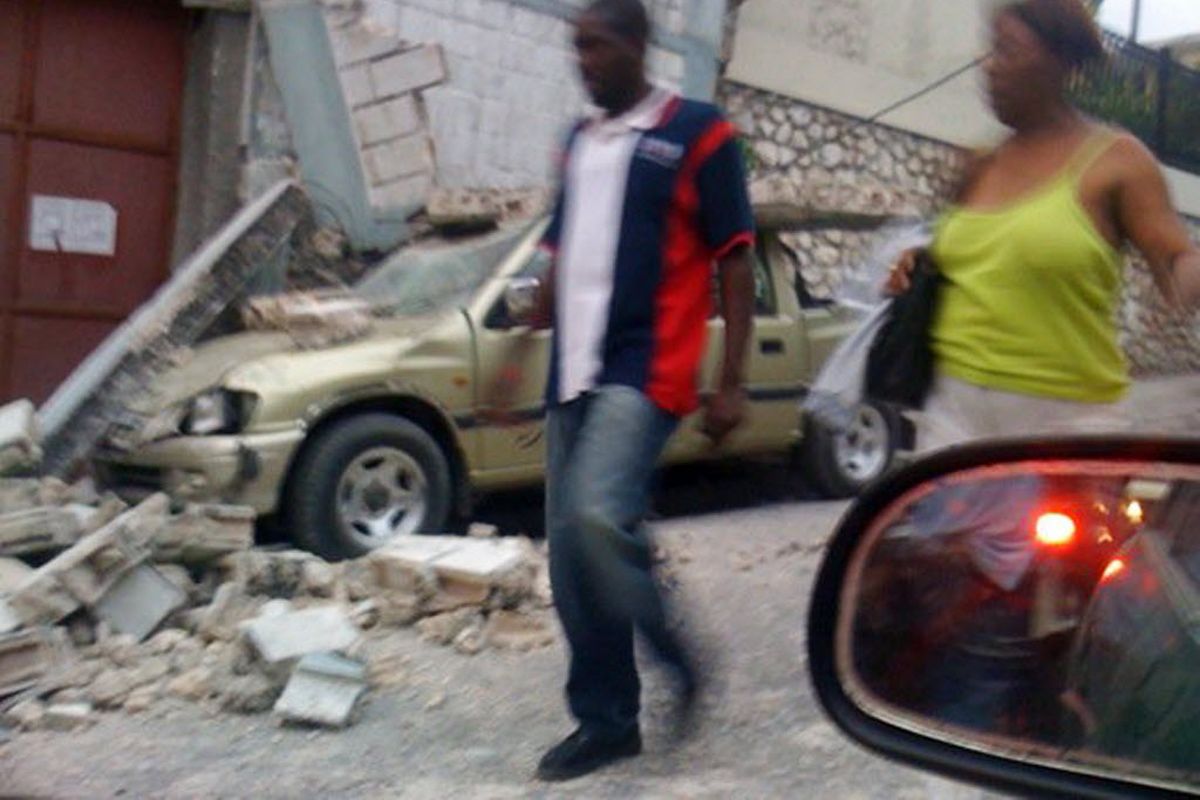Thousands feared dead as aid work begins in Haiti

PORT-AU-PRINCE, Haiti – The earthquake spared neither poor nor powerful: The president was homeless, the U.N. mission chief missing, the archbishop dead. Whole neighborhoods were flattened and perhaps tens of thousands of people killed in the latest catastrophe to befall impoverished Haiti.
Dazed survivors wandered past dead bodies in Port-au-Prince’s rubble-strewn streets Wednesday, crying for loved ones, and rescuers searched collapsed buildings for signs of life.
The first cargo planes with food, water, medical supplies, shelter and sniffer dogs headed to the Western Hemisphere’s poorest nation a day after the magnitude-7.0 quake flattened much of the capital of 2 million people.
Hospitals, schools and the main prison collapsed in Tuesday’s quake. The capital’s Roman Catholic archbishop was killed when his office and the main cathedral fell. The head of the U.N. peacekeeping mission was missing in the ruins of the organization’s multistory headquarters.
At a triage center improvised in a hotel parking lot, people with cuts, broken bones and crushed ribs moaned under tent-like covers fashioned from bloody sheets.
“This is much worse than a hurricane,” said doctors’ assistant Jimitre Coquillon. “There’s no water. There’s nothing. Thirsty people are going to die.”
Bodies were everywhere in Port-au-Prince: those of children adjacent to schools, women in the rubble-strewn streets with stunned expressions frozen on their faces, men hidden beneath plastic tarps and cotton sheets.
Haiti’s leaders struggled to comprehend the extent of the catastrophe – the worst earthquake to hit the country in 200 years – even as aftershocks still reverberated.
President Rene Preval’s gleaming white National Palace didn’t escape the damage – a dome tilted ominously above the manicured grounds.
“It’s incredible,” Preval told CNN. “A lot of houses destroyed, hospitals, schools, personal homes. A lot of people in the street dead. … I’m still looking to understand the magnitude of the event and how to manage.”
Preval said thousands of people were probably killed. Leading Sen. Youri Latortue told the Associated Press that 500,000 could be dead, but conceded that nobody really knows.
Looting began almost as quickly as the quake struck at 4:53 p.m. and people were seen carrying food from collapsed buildings. Many lugged what they could salvage and stacked it around them as they slept in streets and parks.
People streamed into the Haitian countryside, where wooden and cinderblock shacks showed little sign of damage.
The international Red Cross said a third of the country’s 9 million people may need emergency aid, a burden that would test any nation and a crushing catastrophe for impoverished Haiti.
President Barack Obama promised an all-out rescue and humanitarian effort including the military and civilian emergency teams from across the U.S. Late Wednesday, the Navy said the amphibious assault ship USS Bataan had been ordered to sail as soon as possible with a 2,000-member Marine unit to join other warships headed to the Caribbean nation.
“We have to be there for them in their hour of need,” Obama said.
The first C-130 plane carrying part of a military assessment team arrived in Haiti, the U.S. Southern Command said.
The U.S. Navy aircraft carrier, USS Carl Vinson, was expected to arrive off the coast of Haiti on Thursday. More U.S. Navy ships were under way as well, the Southern Command said.
A U.S. Coast Guard helicopter evacuated four critically injured U.S. Embassy staff to the hospital on the U.S. Naval base at Guantanamo Bay, Cuba.
Cuba, which already had hundreds of doctors in Haiti, treated the injured in field hospitals. The aid group Doctors Without Borders helped quake victims in tent clinics set up to replace its damaged facilities.
The body of Archbishop Joseph Serge Miot, 63, was found in the ruins of his office, according to the Rev. Pierre Le Beller at Miot’s order, the Saint Jacques Missionary Center in Landivisiau, France.
Senate President Kelly Bastien was rescued from the collapsed Parliament building and taken to a hospital in the Dominican Republic.
The president of Haiti’s Citibank was also among the survivors being treated there, said Rafael Sanchez Espanol, director of the Homs Hospital in Santiago.
Even the main prison in the capital fell down, “and there are reports of escaped inmates,” U.N. humanitarian spokeswoman Elisabeth Byrs said in Geneva.
Haiti’s quake refugees likely will face an increased risk of dengue fever, malaria and measles – problems that plagued the impoverished country before, said Kimberley Shoaf, associate director of the UCLA Center for Public Health and Disasters.
Some of the biggest immediate health threats include respiratory disease from inhaling dust from collapsed buildings and diarrhea from drinking contaminated water.
She said swamped clinics may not be able to give people help they need for broken bones and other injuries, leading to complications – a warning borne out on the streets where people, some covered in the dust of collapsed buildings, nursed wounds that bled through crude bandages.
U.N. mission head Hedi Annabi of Tunisia was among about 150 people missing, mostly at the headquarters building, said peacekeeping chief Alain Le Roy. Brazilian Foreign Minister Celso Amorim said Annabi’s chief deputy, Luis Carlos da Costa, was missing as well.
Le Roy said only about 10 people had been pulled out, many of them badly injured.
The United Nations said 16 U.N. personnel were confirmed dead and between 100 and 150 U.N. workers were still missing, including U.N. mission head Hedi Annabi of Tunisia and his chief deputy, Luis Carlos da Costa.
The U.S. Embassy had no confirmed reports of deaths among the estimated 40,000-45,000 Americans who live in Haiti, but many were struggling to find a way out of the country.